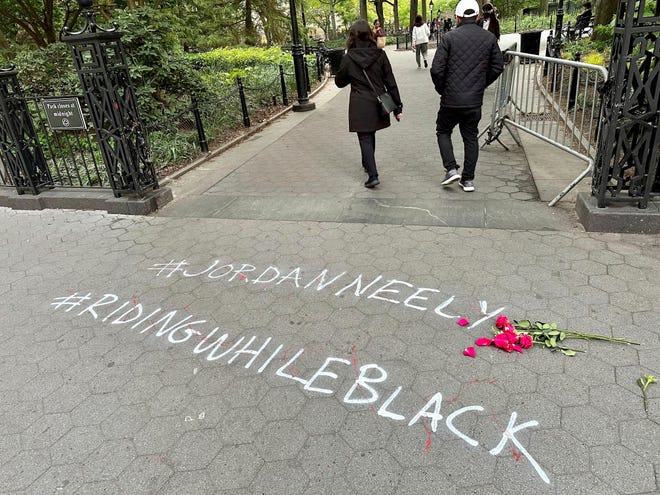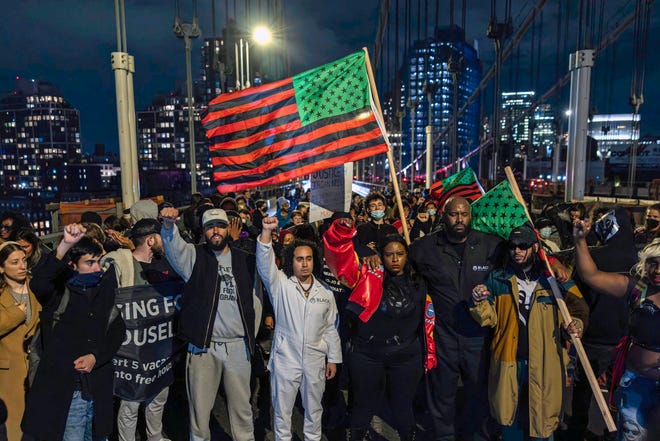New York City’s mayor has urged people not to rush to judgment in the chokehold death of Jordan Neely, but five days after Neely was killed on the subway, authorities still have not provided several important details about the circumstances surrounding his death.
How long did Daniel Penny, a 24-year-old Marine veteran, place Neely in a chokehold? Who else was involved? And what happened leading up to the fatal encounter? The New York Police Department didn’t offer any updates when asked by USA TODAY for more details about the investigation on Saturday.
Neely was a 30-year-old locally-known Michael Jackson impersonator who died Monday in what a medical examiner ruled was homicide by compression of the neck.
In a Friday statement, Penny’s lawyers claimed he acted in self-defense. Advocates, family and Penny’s lawyers have all acknowledged Neely experienced mental illness.
Neely’s death sparked widespread protests in the city, as demonstrators demanded Penny be criminally charged, and prompted renewed conversations about mental health access, systemic racism and the treatment of New York City’s unhoused population.
PREVIOUSLY:Jordan Neely NYC subway chokehold death sparks outcry: ‘We’ve got a deep problem’
Police silent on key questions
On Wednesday, police issued a statement saying they responded to the subway and discovered a 30-year-old man unconscious, who was later pronounced dead. A spokesperson told USA TODAY at the time the man had been in a “verbal dispute” with a 24-year-old that escalated to a “physical altercation.” The victim became unconscious during the altercation, the spokesperson said.
By Saturday, NYPD had added few details to its public statement. Police said Neely was found unconscious on the floor of the train with other people standing at the scene. They added that responders performed CPR and said the medical examiner ruled the death a homicide.
Police also withheld Penny’s name for several days. Penny’s lawyers later released a statement on his behalf Friday amid building pressure on social media and from advocates for his identity to become public.
But many questions were still unanswered by authorities nearly a week after Neely’s death.
Police did not provide updates from the investigation Saturday about what led up to Penny placing him in a chokehold, how long it lasted, or the identities of the other train passengers who helped Penny restrain Neely.
Video of the incident shows Penny with his arms wrapped around Neely’s neck for roughly three minutes as they were on the floor of the subway car. A second passenger pinned Neely’s arms while a third person held down his shoulder.
Freelance journalist Juan Alberto Vazquez, who recorded the footage, said the men were in that position for “at least 15 minutes.”
Attorney Lennon Edwards, one of the lawyers representing Neely’s family, said he “took this case because 15 minutes is too long to go without help, intervention and without air.”
“Passengers are not supposed to die on the floor of our subways,” he said in a Thursday statement.
Who was Jordan Neely?
Neely was known locally as a Michael Jackson impersonator who danced in the Times Square transit hub and was a beloved part of many New Yorkers’ daily commute.
Jason Williams, an actor, met Neely in 2007 and described him as an agile Michael Jackson impersonator who moonwalked through the subway and lip-synced to “Billie Jean.”
“He embodied the hustle spirit of New York,” Williams said. “He was a great performer and it’s a real tragedy that he was killed so senselessly.”
Street performers who knew him described him as kind and gifted. They also said he suffered from worsening mental health and sunk into a depression as a result of his mother’s 2007 death.

The New York law firm Mills & Edwards LLP, which is representing Neely’s family, confirmed he experienced mental illness that began “when he experienced the brutal murder of his mother.” Neely was 14 at the time, according to the law firm.
“It is a tragedy for all of us to know that Jordan Neely’s life was also cut short,” the law firm said in a statement.
Neely’s mother was strangled, and Neely testified against his mother’s boyfriend at the murder trial, according to news reports from the time.
Tari Tudesco, a backup dancer in the Michael Jackson tribute act “Michael’s Mirror,” said many in the street performer community were searching for Neely, worried about his absence in recent years.
“We were in shock to find now that he was living homeless,” she said. “We feel terrible.”
Authorities said it appeared Neely was unhoused.
Daniel Penny’s attorneys release statement
The attorneys representing Daniel Penny defended his actions as self-defense in a Friday statement. Penny “never intended to harm Mr. Neely and could not have foreseen his untimely death,” said his lawyers, Thomas Kenniff and Steven Raiser.
Penny’s lawyers offered few details of what happened leading up to Neely’s death but said Penny was protecting himself after Neely threatened him and others.
“When Mr. Neely began aggressively threatening Daniel Penny and the other passengers, Daniel, with the help of others, acted to protect themselves, until help arrived,” the statement said.

Jordan Neely’s death sparks protests, outrage
Hundreds of people protested Neely’s death in New York City this week, demanding criminal charges against Penny and expressing anger over the treatment of unhoused people, especially people of color and people experiencing mental health struggles.
“We’ve got a deep problem in this country in thinking that it’s OK to deploy violence to deal with mental health,” said Rashad Robinson, president of the online-focused civil rights group Color Of Change. “The fact is that Black people just don’t have to worry about being strangled by police, but by a regular citizen feeling empowered and supported by elected officials.”
New York officials respond to fatal chokehold on subway

Democratic New York congresswoman Alexandria Ocasio-Cortez called Neely’s death murder and criticized officials’ response to the incident.
“This honestly feels like a new low: not being able to clearly condemn a public murder because the victim was of a social status some would deem ‘too low’ to care about,” Ocasio-Cortez said.
Gov. Kathy Hochul said footage of the incident was “horrific,” adding that Neely’s family “deserves justice” and that it was “very clear” Neely was not going to harm others.
“No one has the right to take the life of another person,” she said.
Meanwhile, Mayor Eric Adams again declined to assign blame in an interview with CNN.
“We cannot just blatantly say what a passenger should or should not do in a situation like that, and we should allow the investigation to take its course,” he said.
Contributing: Claire Thornton and Trevor Hughes, USA TODAY; The Associated Press

